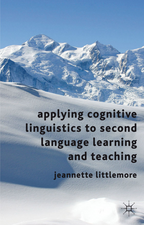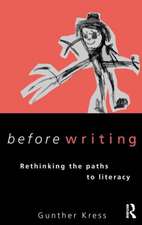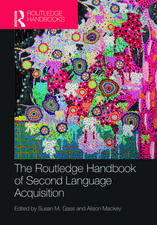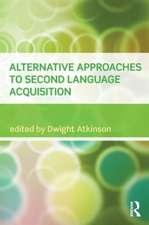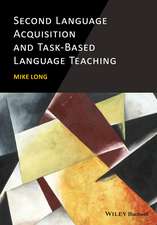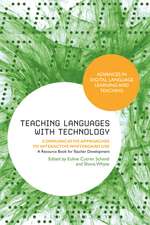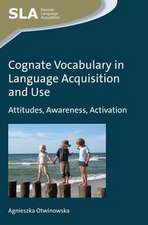The Resilience of Language: What Gesture Creation in Deaf Children Can Tell Us About How All Children Learn Language: Essays in Developmental Psychology
Autor Susan Goldin-Meadowen Limba Engleză Paperback – 5 apr 2005
| Toate formatele și edițiile | Preț | Express |
|---|---|---|
| Paperback (1) | 447.51 lei 6-8 săpt. | |
| Taylor & Francis – 5 apr 2005 | 447.51 lei 6-8 săpt. | |
| Hardback (1) | 1006.60 lei 6-8 săpt. | |
| Taylor & Francis – 11 apr 2003 | 1006.60 lei 6-8 săpt. |
Din seria Essays in Developmental Psychology
-
 Preț: 295.14 lei
Preț: 295.14 lei -
 Preț: 339.90 lei
Preț: 339.90 lei - 15%
 Preț: 296.31 lei
Preț: 296.31 lei - 25%
 Preț: 471.35 lei
Preț: 471.35 lei -
 Preț: 460.69 lei
Preț: 460.69 lei -
 Preț: 461.66 lei
Preț: 461.66 lei - 18%
 Preț: 1003.30 lei
Preț: 1003.30 lei -
 Preț: 491.01 lei
Preț: 491.01 lei - 48%
 Preț: 514.10 lei
Preț: 514.10 lei -
 Preț: 412.37 lei
Preț: 412.37 lei -
 Preț: 438.86 lei
Preț: 438.86 lei - 13%
 Preț: 350.33 lei
Preț: 350.33 lei -
 Preț: 407.57 lei
Preț: 407.57 lei -
 Preț: 470.32 lei
Preț: 470.32 lei -
 Preț: 464.93 lei
Preț: 464.93 lei -
 Preț: 388.10 lei
Preț: 388.10 lei -
 Preț: 364.86 lei
Preț: 364.86 lei - 34%
 Preț: 764.20 lei
Preț: 764.20 lei -
 Preț: 367.83 lei
Preț: 367.83 lei - 26%
 Preț: 990.09 lei
Preț: 990.09 lei - 15%
 Preț: 420.18 lei
Preț: 420.18 lei - 18%
 Preț: 1004.86 lei
Preț: 1004.86 lei - 26%
 Preț: 765.43 lei
Preț: 765.43 lei
Preț: 447.51 lei
Nou
Puncte Express: 671
Preț estimativ în valută:
85.63€ • 89.63$ • 71.27£
85.63€ • 89.63$ • 71.27£
Carte tipărită la comandă
Livrare economică 31 martie-14 aprilie
Preluare comenzi: 021 569.72.76
Specificații
ISBN-13: 9781841694368
ISBN-10: 1841694363
Pagini: 288
Ilustrații: 54 black & white illustrations
Dimensiuni: 152 x 229 x 15 mm
Greutate: 0.41 kg
Ediția:UK edition
Editura: Taylor & Francis
Colecția Psychology Press
Seria Essays in Developmental Psychology
Locul publicării:Oxford, United Kingdom
ISBN-10: 1841694363
Pagini: 288
Ilustrații: 54 black & white illustrations
Dimensiuni: 152 x 229 x 15 mm
Greutate: 0.41 kg
Ediția:UK edition
Editura: Taylor & Francis
Colecția Psychology Press
Seria Essays in Developmental Psychology
Locul publicării:Oxford, United Kingdom
Recenzii
'This book is interesting, well written and easy to read. I recommend it highly to all students and researchers who are interested in gesture.' - Sandra Smith, Deafness & Educational International
'The data described...inform the study of language acquisistion generally, as well as contributing immensely to the understanding of language and communication in exceptional circumstances. ... It will appeal to those with an interest in language development or with a specific interest in communication and hearing impairment. it would also complement the core texts for any course on language development, and its accessible style should appeal to a wide readership.' - Dr Fiona Lyddy, in The Irish Psychologist, May 2006.
'The data described...inform the study of language acquisistion generally, as well as contributing immensely to the understanding of language and communication in exceptional circumstances. ... It will appeal to those with an interest in language development or with a specific interest in communication and hearing impairment. it would also complement the core texts for any course on language development, and its accessible style should appeal to a wide readership.' - Dr Fiona Lyddy, in The Irish Psychologist, May 2006.
Cuprins
Part 1: The Problem of Language Learning. Out of the Mouths of Babes. How Do Children Learn Language? Language-Learning Across the Globe. Language-Learning by Hand. Does More or Less Input Matter? Part 2: Language Development without a Language Model. Background on Deafness and Language-Learning. How Do We Begin? Words. The Parts of Words. Combining Words Into Simple Sentences. Making Complex Sentences out of Simple Ones: Recursion. Building a System. Beyond the Here-And-Now: The Functions Gesture Serves. How Might Hearing Parents Foster Gesture Creation in Their Deaf Children? Gesture Creation Across the Globe. Part 3: The Conditions that Foster Language and Language-Learning. How Do the Resilient Properties of Language Help Children Learn Language? When Does Gesture Become Language? Is Language Innate? The Resilience of Language. References. Author Index. Subject Index.
Descriere
Imagine a child who has never seen or heard any language at all. Would such a child be able to invent a language on her own? Despite what one might guess, the children described in this book make it clear that the answer to this question is 'yes'.



